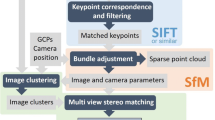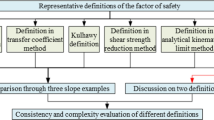Abstract
We studied intra-annual wood density profiles of Douglas-fir tree rings (Pseudotsuga menziesii [Mirb.] Franco) in southwestern Germany. Growth rates are variable around the tree circumference. This leads to differences in wood formation, which can be observed in the shape of the density profiles of the same tree ring measured in different radial directions. Due to this spatial variation in density profiles, we need a reliable method to determine an average profile, which preserves the common characteristics of the data. To this end, we developed a multiple interval-based curve alignment (MICA) procedure. It identifies characteristic points within the profiles such as minima, maxima and inflection points. These reference points are shifted gradually against each other within a proportionally defined baseline interval. Using our progressive alignment approach, we are able to calculate an average profile that represents very well the characteristics of all measured curves of a specific tree ring. We applied the procedure to get year-specific average profiles using various trees. This results in representative mean density profiles that preserve the density variations common to all aligned profiles. Individual noise is reduced, thereby enabling the analysis of the impact of weather variations on wood density.





Similar content being viewed by others
Notes
Using the lm function from the R stats package.
References
Battipaglia G, De Micco V, Brand WA, Linke P, Aronne G, Saurer M, Cherubini P (2010) Variations of vessel diameter and δ13C in false rings of Arbustus unedo L. reflect different environmental conditions. New Phytol 188:1099–1112
Bookstein FL (1978) The measurement of biological shape and shape change. Syst Zool 29:102–104
Briffa KR, Osborn TJ, Schweingruber FH, Harris IC, Jones PD, Shiyatov SG, Vaganov EA (2001) Low-frequency temperature variations from northern ring density network. J Geophys Res 106:2929–2941
Coffey N, Hinde J (2011) Analyzing time-course microarray data using functional data analysis—a review. Stat Appl Genet Mol 10(1):Article 23
De Micco V, Saurer M, Aronne G, Tognetti R, Cherobini P (2007) Variations of wood anatomy and δ13C of coastal Pinus pinaster showing intra-annual density fluctuations. IAWA J 28(1):61–74
Domec JC, Gartner BL (2002) Age- and position-related changes in hydraulic versus mechanical dysfunction of xylem: inferring the design criteria for Douglas-fir wood structure. Tree Physiol 22:91–104
Feng D, Doolittle RF (1987) Progressive sequence alignment as a prerequisite to correct phylogenetic trees. J Mol Evol 60:351–360
Fritts HC (1976) Tree rings and climate. Academic Press, London/New York/San Francisco, p 567
Higgins DG, Thompson JD, Gibson TJ (1994) CLUSTAL W: improving the sensitivity of progressive multiple sequence alignment through sequence weighting, position-specific gap penalties and weight matrix choice. Nucleic Acids Res 22:4673–4680
Ihaka R, Gentleman R (1996) R: a language for data analysis and graphics. J Comput Graph Stat 5:299–314
Kneip A, Gasser T (1992) Statistical tools to analyze data representing a sample of curves. Ann Statist 20(3):1266–1305
Kneip A, Ramsay JO (2008) Combining registration and fitting for functional models. J Amer Statistical Assoc 103(483):1155–1165
Kozlowski TT (1971) Growth and development of trees, vol II. Academic Press, London/New York, p 514
Otto W, Will S, Backofen R (2008) Structure local multiple alignment of RNA. In: Proceedings of German conference on bioinformatics (GCB’2008). Lecture notes in informatics (LNI) vol 136. Dresden, Germany, pp 178–188, 9–12 Sept 2008
Ramsay JO, Li X (1998) Curve registration. J R Stat Soc Ser B Stat Methodol 60:351–363
Rigling A, Waldner PO, Forster T, Bräker OU, Pouttu A (2001) Ecological interpretation of tree-ring width and intra-annual density fluctuations in Pinus sylvestris on dry sites in the central Alps and Siberia. Can J For Res 31:18–31
Rigling A, Bräker O, Schneiter G, Schweingruber F (2002) Intra-annual tree-ring parameters indicating differences in drought stress in Pinus sylvestris forests within the Erico-Pinion in the Valais (Switzerland). Plant Ecol 163:105–121
Rozenberg P, Van Loo J, Hannrup B, Grabner M (2002) Clonal variation of wood density record of cambium reaction to water deficit in Picea abies (L.) Karst. Ann For Sci 59:533–540
Sangalli LM, Secchi PC, Vantini S, Vitelli V (2010) k-mean alignment for curve clustering. Comput Stat Data Anal 54:1219–1233
Schinker MG, Hansen N, Spiecker H (2003) High-frequency densitometry: a new method for the rapid evaluation of wood density variations. IAWA J 24(3):231–239
Schweingruber FH (1988) Tree rings: basics and applications of dendrochronology. Dordrecht, Reidel, p 276
Sebastian TB, Klein PN, Kimia BB (2003) On aligning curves. IEEE T Pattern Anal 25(1):116–125
Spiecker H, Schinker MG, Hansen N, Park Y-I, Ebding T, Döll W (2000) Cell structure in tree rings: novel methods for preparation and image analysis of large cross sections. IAWA J 21(3):361–373
Torgovnikov GI (1990) Dielektrische Eigenschaften von absolut trockenem Holz und Holzstoff. Holztechnologie 31:9–11
Vaganov EA, Hughes MK, Shashkin AV (2006) Growth dynamics of conifer tree rings: images of past and future environments. Springer, Berlin/Heidelberg/New York, p 354
Wimmer R, Strumia G, Holawe F (2000) Use of false rings in Austrian pine to reconstruct early growing season precipitation. Can J For Res 30:1691–1697
Wirtz B (1997) Average prototypes for stroke-based signature verification. In: Proceedings of the fourth international conference on document analysis and recognition (ICDAR’97), pp 18–20. Aug 1997, Ulm, Germany, 268–272
Acknowledgments
This work was partially supported by grants EXC 294 and DFG SP 437/15-1.
Author information
Authors and Affiliations
Corresponding authors
Additional information
Communicated by S. Leavitt.
The authors Bela J. Bender and Martin Mann contributed equally to this work.
Rights and permissions
About this article
Cite this article
Bender, B.J., Mann, M., Backofen, R. et al. Microstructure alignment of wood density profiles: an approach to equalize radial differences in growth rate. Trees 26, 1267–1274 (2012). https://doi.org/10.1007/s00468-012-0702-y
Received:
Revised:
Accepted:
Published:
Issue Date:
DOI: https://doi.org/10.1007/s00468-012-0702-y




